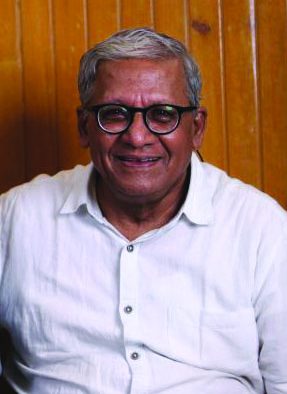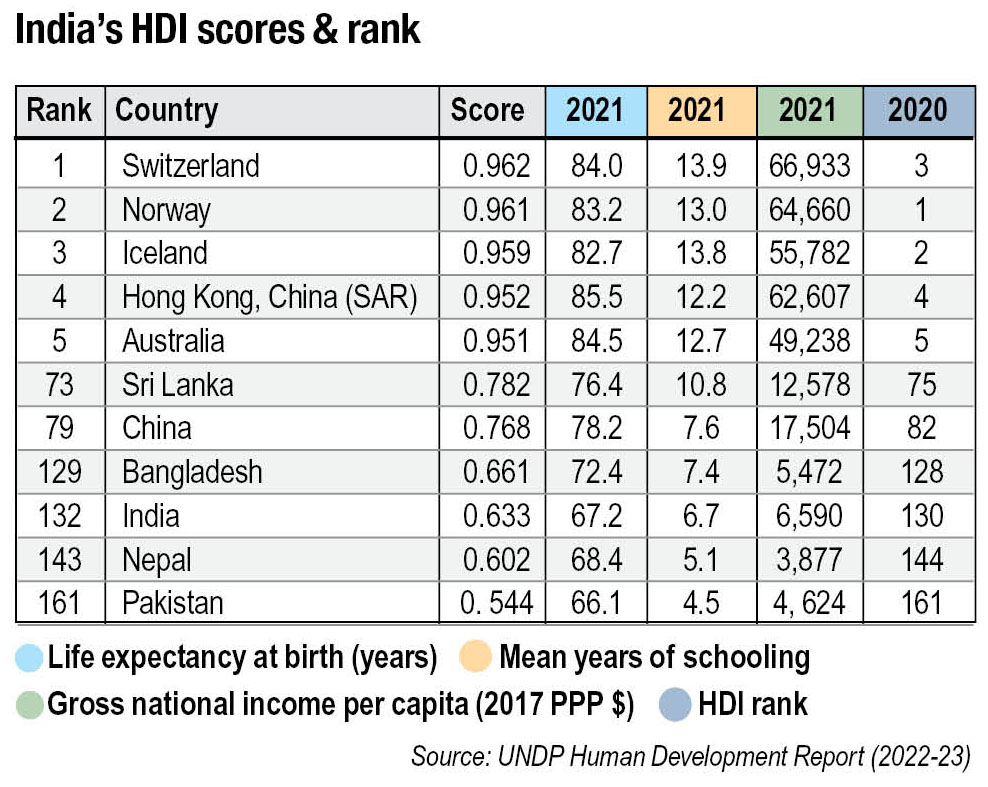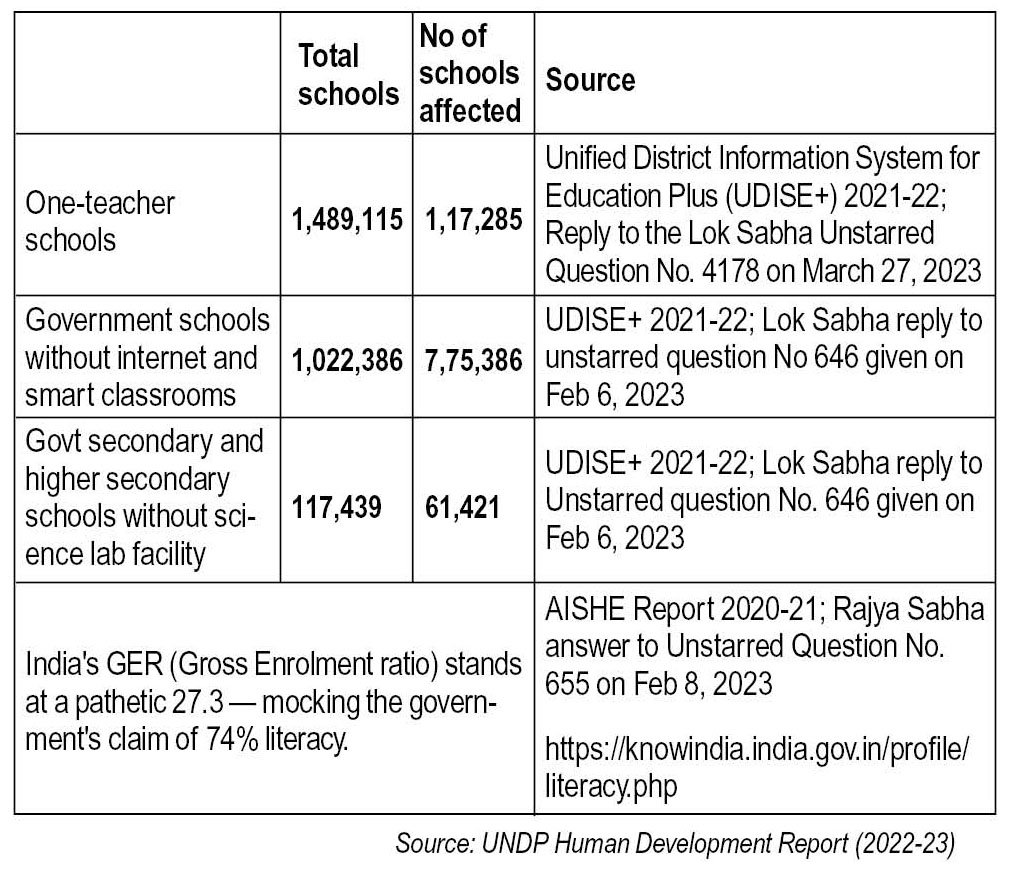 – R.N. Bhaskar, senior journalist, educationist, and researcher
– R.N. Bhaskar, senior journalist, educationist, and researcher
For chest-thumping hyper-nationalist government and ruling BJP spokespersons claiming that India is the world’s fastest growing economy, the third largest global economy and set to become a viswaguru (world teacher), UNDP’s latest Human Development Report 2022-23 is a rude awakening. India’s ranking has slipped from #130 in 2020 to #132 in 2021. Many of our neighbouring nations — including Bangladesh — are ranked higher.
Surprisingly, there is inadequate awareness within policy formulators and society that India’s greatest resource is its people. There are too many establishment figures who say that a large population is a developmental disadvantage. But China was the world’s most populous country until last year. After Secretary Deng Xiaoping liberated the Chinese economy from the yoke of socialism in 1978, China averaged 10 percent per year GDP growth rate for 30 years (1978-2008) and showed the world that when human resources are nurtured and rational policies implemented, a heavily populated country can become a global powerhouse.
 The real test of a nation’s strength depends on how it has nurtured its human resources. But this is precisely where India’s record is pathetic.
The real test of a nation’s strength depends on how it has nurtured its human resources. But this is precisely where India’s record is pathetic.
- In terms of life expectancy, India has the worst record, except for Pakistan.
- In terms of number of years of school education, India once again scrapes the bottom, except for Pakistan.
- In terms of mean years of schooling, India is better than only Pakistan and Nepal.
The sole consolation is that India’s data are better than Pakistan. But that can’t obfuscate the reality that India is a pathetic also-ran in global rankings, and that its ranking slipped in 2021.
India’s primary-secondary education data is depressing. As many as 117,000 schools have just one teacher, teaching all classes and all subjects. Moreover, 775,000 out of 1,022,000 government schools are without internet connectivity and smart classrooms. More than half of government secondary and higher secondary schools don’t have a science laboratory. With this degree of deprivation, how can our children compete with their peers in developed OECD countries in the new globalised world? The reality is that most of these children will become unemployable. They have wasted ten of their most creative years in schools that actually destroy talent rather than nurture it.
 Further investigation of data will unearth the reality that the majority of such schools and students are sited in the Hindi speaking states of north India whose MPs dominate Parliament. That is why the proposed delimitation of parliamentary constituencies under which the BJP government at the Centre wants to increase the representation of Hindi states in Parliament, is causing much heartburn in the southern states which have a much better HDI record.
Further investigation of data will unearth the reality that the majority of such schools and students are sited in the Hindi speaking states of north India whose MPs dominate Parliament. That is why the proposed delimitation of parliamentary constituencies under which the BJP government at the Centre wants to increase the representation of Hindi states in Parliament, is causing much heartburn in the southern states which have a much better HDI record.
The situation isn’t better in higher education. A study of the Central government’s own data indicates that India’s GER (gross enrolment ratio) in higher education is a modest 27.3 percent of youth of college-going age (18-24). This is way below the 70 percent score of developed OECD countries.
The plain truth is that India needs to develop its abundant human resources. If we don’t do this soon, India will become a country of much bluff and bluster but little else. The next HDI Index and Report will be out in March. I don’t have great expectations.
Also read: Squeezing the budget for human capital development

Poor human capital development record
For chest-thumping hyper-nationalist government and ruling BJP spokespersons claiming that India is the world’s fastest growing economy, the third largest global economy and set to become a viswaguru (world teacher), UNDP’s latest Human Development Report 2022-23 is a rude awakening. India’s ranking has slipped from #130 in 2020 to #132 in 2021. Many of our neighbouring nations — including Bangladesh — are ranked higher.
Surprisingly, there is inadequate awareness within policy formulators and society that India’s greatest resource is its people. There are too many establishment figures who say that a large population is a developmental disadvantage. But China was the world’s most populous country until last year. After Secretary Deng Xiaoping liberated the Chinese economy from the yoke of socialism in 1978, China averaged 10 percent per year GDP growth rate for 30 years (1978-2008) and showed the world that when human resources are nurtured and rational policies implemented, a heavily populated country can become a global powerhouse.
The sole consolation is that India’s data are better than Pakistan. But that can’t obfuscate the reality that India is a pathetic also-ran in global rankings, and that its ranking slipped in 2021.
India’s primary-secondary education data is depressing. As many as 117,000 schools have just one teacher, teaching all classes and all subjects. Moreover, 775,000 out of 1,022,000 government schools are without internet connectivity and smart classrooms. More than half of government secondary and higher secondary schools don’t have a science laboratory. With this degree of deprivation, how can our children compete with their peers in developed OECD countries in the new globalised world? The reality is that most of these children will become unemployable. They have wasted ten of their most creative years in schools that actually destroy talent rather than nurture it.
The situation isn’t better in higher education. A study of the Central government’s own data indicates that India’s GER (gross enrolment ratio) in higher education is a modest 27.3 percent of youth of college-going age (18-24). This is way below the 70 percent score of developed OECD countries.
The plain truth is that India needs to develop its abundant human resources. If we don’t do this soon, India will become a country of much bluff and bluster but little else. The next HDI Index and Report will be out in March. I don’t have great expectations.
Also read: Squeezing the budget for human capital development